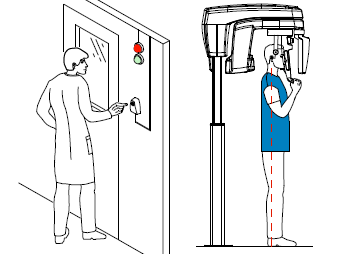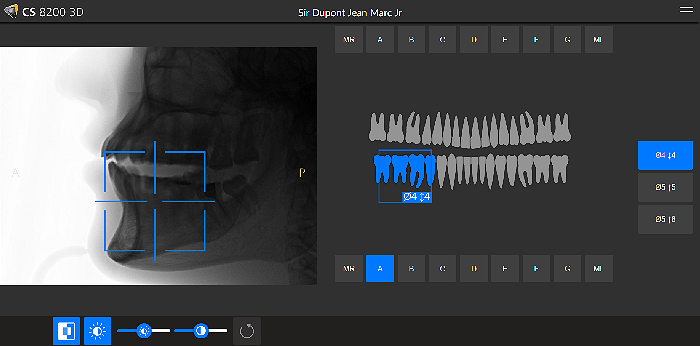Launching the X-Ray for 3D Teeth Images
To launch the X-ray, follow these steps:
-
Leave the X-ray room and close the door. You must keep visual contact with the patient during acquisition.

IMPORTANT: If you need to stop the acquisition due to a problem, release the exposure button of the remote control, or press the red emergency stop button.

-
If you want to perform a scout view:
-
Click
 , then launch an X-ray with the remote control. The Scout view 2D screen will display the image:
, then launch an X-ray with the remote control. The Scout view 2D screen will display the image:
-

 |
Note: You can move the area of interest by selecting the alphabetical labels. |
-
Once the scout view is done, the button becomes gray. You can perform another scout view by clicking the scout view button (which turned blue) and re-doing the scout view action.
-
Click
 to change the contrast from black to white or white to black.
to change the contrast from black to white or white to black. -
To adjust for brightness or contrast, use
 .
. -
To set contrast change, brightness or contrast to default, click
 .
.
-
Launch the X-ray with the remote control:

IMPORTANT: If you need to stop the acquisition due to a problem, release the exposure button of the remote control, or press the red emergency stop button.
The ![]() turns yellow, and a warning sound is heard, indicating X-ray emission.
turns yellow, and a warning sound is heard, indicating X-ray emission.
Press and hold the exposure button until the end of the acquisition is indicated by the on-screen “Release Handswitch” message.
When the acquisition ends, the Acquisition interface disappears, and the acquired image is automatically transferred to the Imaging window. When the acquisition ends, the acquired image is displayed on your screen.
-
Do the following when the acquisition is finished:
-
Open the temple supports and release the patient.
-
Return the metal objects in the jewelry tray to the patient.
-
Remove the hygiene barrier of the bite block.
-
Reset the unit rotative arm for the next acquisition.
-
X-Ray Dose Emission Information
Compliance with Directive 2013/59/Euratom
You can right-click on each image to display the estimated emitted dose received by the patient. You can use this information to calculate the effective dose received by the patient for the image.
The radiation emission dose is expressed in mGy.cm2. This dose is measured at the primary collimator outlet. The dose is accurate to +/-30%.
